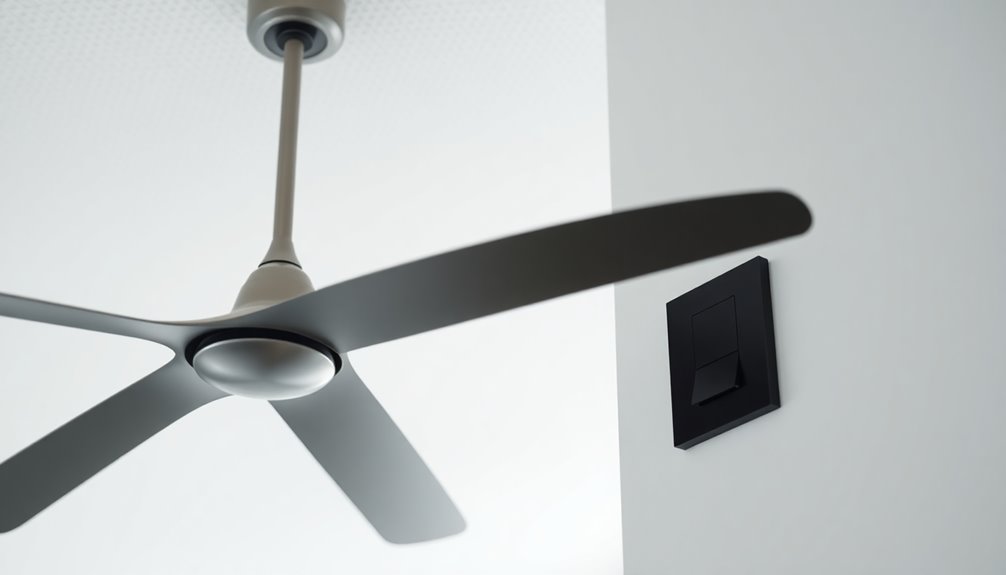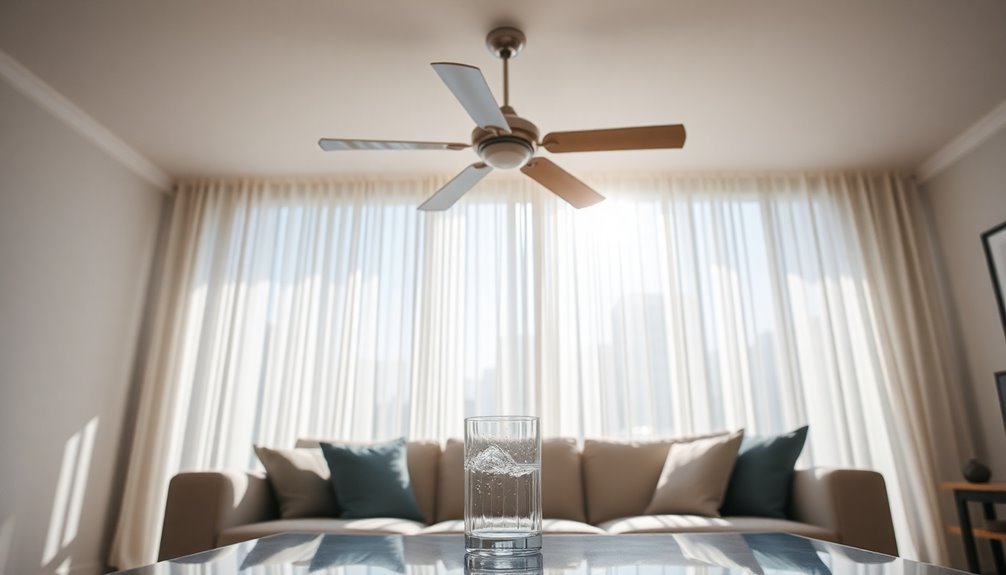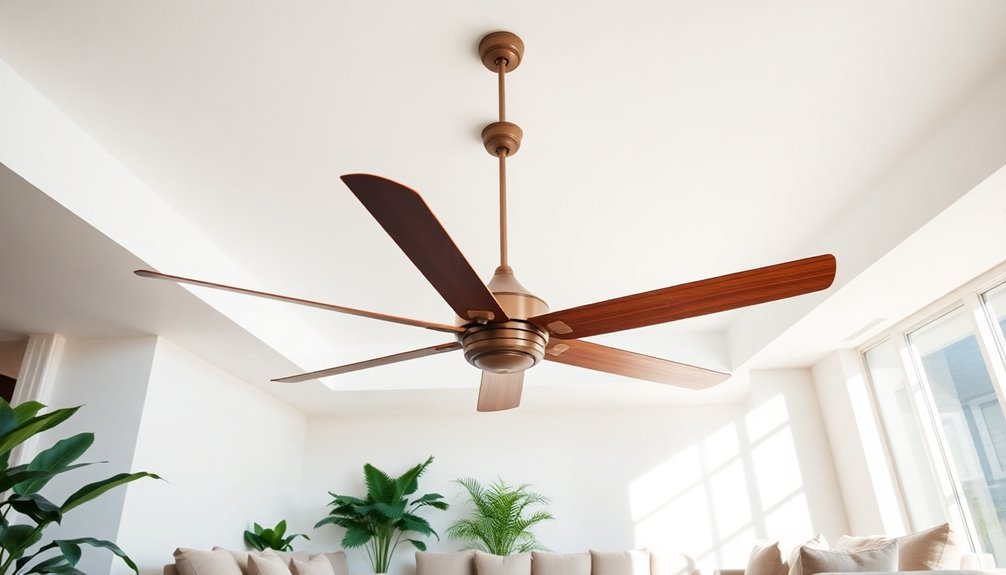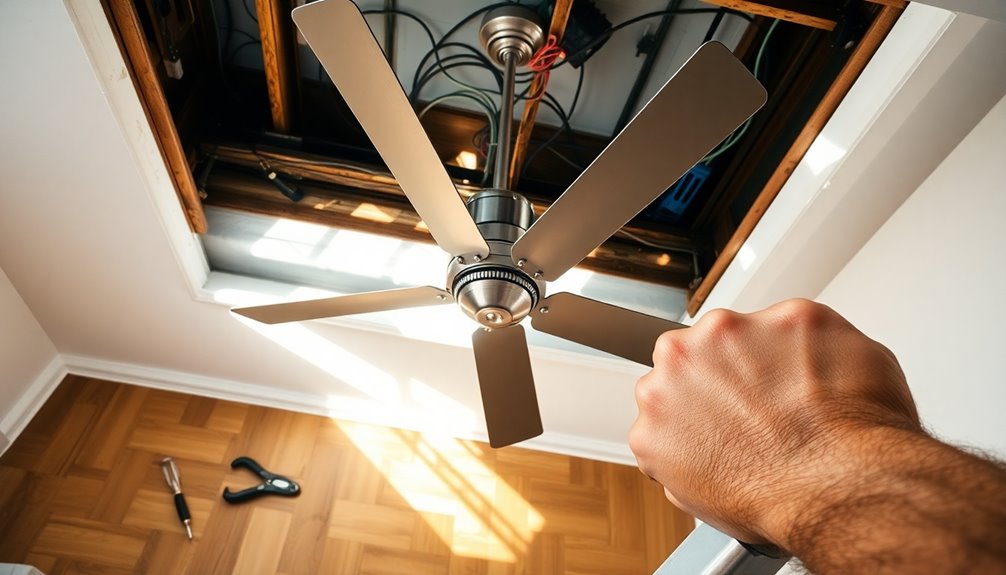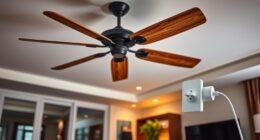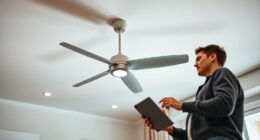Ceiling fans usually draw between 0.2 to 6 amps, depending on their size and efficiency. Most standard fans operate at about 0.5 to 0.8 amps, while low-profile or bladeless models are more efficient, pulling around 0.3 to 0.5 amps. Smart fans are even better, drawing just 0.2 to 0.3 amps. Keep in mind that startup amperage can be 2 to 3 times higher than normal. Understanding how much power your fan uses can help you manage your electricity costs wisely. Stick around to discover tips for maximizing your fan's efficiency and reducing your electricity bills.
Key Takeaways
- Ceiling fans typically draw between 0.2 to 6 amps, with an average around 0.5 amps for standard models.
- Low-profile and bladeless fans are more efficient, consuming 0.3 to 0.5 amps.
- Smart ceiling fans are the most efficient, drawing only 0.2 to 0.3 amps.
- Startup amperage can be 2-3 times higher than the normal draw, requiring more current initially.
- Proper wire gauge, like 14-gauge, is essential for supporting the fan's amperage safely.
Key Takeaways

Understanding how many amps a ceiling fan draws is essential for guaranteeing proper electrical setup in your home. Typically, ceiling fans consume between 0.2 to 6 amps, depending on their size, type, and efficiency. Most standard ceiling fans operate around 0.5 to 0.8 amps at 120V, while ENERGY STAR® models can be even more efficient, drawing as little as 0.4 amps.
If you're considering fan size, a 1200mm three-blade fan usually uses about 0.3 to 0.4 amps, whereas larger fans, like a 1300mm fan, may draw between 0.7 to 1.2 amps.
One thing to remember is that startup amperage can be considerably higher—often 2-3 times the running amperage—so you'll need to guarantee your power supply can handle this initial demand.
When calculating electrical loads, a 15 amp circuit can safely support multiple ceiling fans, each typically drawing around 0.5 amps.
Definition of Electrical Units

When it comes to ceiling fans, grasping the basic electrical units is essential for managing their power consumption effectively. The primary unit you'll encounter is amps, which measure the flow of electrical current in a circuit. This tells you how much electricity your ceiling fan is drawing while it operates.
For instance, standard ceiling fans typically draw between 0.2 to 1.2 amps, depending on their size and type.
Another important electrical unit is volts, representing the electrical potential that drives the current. Understanding volts is vital, as they help explain how amps and watts relate to your fan's power consumption.
Watts quantify the rate of energy usage, and you can calculate them using the formula: Watts = Volts × Amps.
For example, if your ceiling fan operates at 70 watts on high speed and is connected to a 120V power source, it would draw approximately 0.58 amps (70W ÷ 120V = 0.58A).
Knowing these units enables you to make informed decisions about energy efficiency and how to optimize your ceiling fan's performance.
Amperage by Ceiling Fan Type

Different types of ceiling fans draw varying amounts of amperage, which directly affects their power consumption and efficiency.
Understanding how many amps your ceiling fan uses can help you choose the right one for your needs.
Here's a breakdown of the amperage by ceiling fan type:
- Standard Ceiling Fans: Typically draw between 0.6 to 0.8 amps, consuming around 75-100 watts during operation.
- Low-Profile or Bladeless Fans: These fans are more efficient, drawing about 0.3 to 0.5 amps and using 40-60 watts.
- ENERGY STAR® Rated Fans: Designed for maximum efficiency, they consume around 0.4 amps and use 48-52 watts.
- Smart Ceiling Fans: Among the most efficient options, these fans usually draw only 0.2 to 0.3 amps and consume just 28-35 watts. Additionally, selecting a fan with a high CFM rating can further enhance its cooling effectiveness.
Startup Amperage Considerations

Knowing the amperage draw of your ceiling fan is important, but it's equally vital to contemplate the startup amperage. When you first turn on your ceiling fan, the startup amperage can be considerably higher than its running amperage, often reaching 2-3 times the normal draw.
For example, if your fan has a running wattage of 70 watts, it might pull around 1.25 amps at startup due to this surge in power requirements. This surge wattage is necessary to kickstart the idle compressor, and it varies based on the fan's size and motor type.
Because of this initial spike, you must verify that your electrical circuit can handle the startup amperage. If the circuit isn't rated to manage this surge, you could end up tripping breakers or, worse, damaging your fan.
Understanding the startup amperage is essential for selecting the appropriate circuit breakers and wiring. By doing so, you'll prevent overloads during your fan's operation, guaranteeing both safety and longevity.
Calculating Ceiling Fan Amps

Calculating the amps drawn by a ceiling fan is straightforward and essential for guaranteeing proper installation and operation. Here's how you can determine the amps for your ceiling fan:
- Identify the Fan Size: A typical 1200mm three-blade fan usually consumes about 0.3-0.4 amps, while larger 1300mm fans can draw 0.7-1.2 amps.
- Check Wattage: Most standard fans operate around 70 watts on high speed. To find the amps, use the formula: Amps = Watts ÷ Volts.
- Consider Energy Efficiency: Energy Star® ceiling fans are efficient, often using only 0.4 amps while still providing good airflow.
- Factor in Startup Amperage: Remember that during startup, fans can draw 2-3 times more current than they do while running, which can impact your power supply.
Using these steps, you can effectively calculate the amps your ceiling fan will draw.
This information not only helps in selecting the right fan but also guarantees it operates safely and efficiently within your electrical system.
Tips to Reduce Electricity Costs

Reducing electricity costs can be as simple as making a few adjustments in how you use your ceiling fan. Start by raising your thermostat by 4°F when using air conditioning. This minor change, combined with ceiling fans, can help circulate air without overworking your cooling system.
To maximize efficiency, install your ceiling fan at a height of 7 to 9 feet. Larger blade fans are also worth considering, as they provide lower velocity cooling, which is more energy-efficient. Regularly cleaning fan blades is essential, too; dust buildup can hinder performance and lead to increased energy consumption. Additionally, regular maintenance can prevent potential issues that may cause your fan to draw more electricity than necessary.
Lastly, remember to turn off your ceiling fans when you're not using them. Ceiling fans typically draw between 0.2 to 1.2 amps, depending on the model and speed settings. Here's a quick reference table to help you understand the impact of your fan use:
| Action | Impact on Energy Use | Amps Drawn |
|---|---|---|
| Raise thermostat | Decreases cooling need | 0.2 to 1.2 amps |
| Install at 7-9 ft | Enhances airflow | 0.2 to 1.2 amps |
| Clean fan blades | Improves efficiency | 0.2 to 1.2 amps |
Implement these tips to start saving on your electricity costs today!
Benefits of Solar Generators

When you're looking for an efficient way to power your ceiling fan, solar generators offer a fantastic solution.
They provide portable and convenient energy production while being eco-friendly.
Efficient Energy Production
Harnessing the power of the sun, solar generators offer a sustainable solution for energy production that benefits both your wallet and the environment. By utilizing solar energy, you can efficiently power ceiling fans while reducing reliance on traditional electricity.
Here are some key benefits:
- Cost Savings: Solar generators lower your energy bills by using free sunlight to produce electricity.
- Versatility: Models like Jackery Solar Generators support a range of ceiling fans, with capacities from 288Wh to 1264.64Wh, making them perfect for any setting.
- Effective Energy Conversion: Monocrystalline solar cells capture sunlight efficiently, converting it into usable electrical energy (AC) for your fans. Additionally, the efficiency of solar generators can be further enhanced by proper insulation in the home.
- Optimal Performance: With ceiling fan energy consumption varying from 0.2 to 1.2 amps, you can easily match a solar generator to your fan's needs for the best results.
Moreover, investing in solar generators aligns with the growing trend of renewable energy technologies that aim to reduce environmental impact and improve sustainability.
Integrating solar generators into your energy system not only cuts costs but also promotes a cleaner, more sustainable environment.
Portability and Convenience
Portability is a standout feature of solar generators, making them an ideal choice for powering ceiling fans wherever you need them. Whether you're camping, tailgating, or facing an emergency, these generators provide a renewable energy source without the hassle of traditional electrical outlets.
| Feature | Jackery Solar Generator 300 Plus | Jackery Solar Generator 600 Plus |
|---|---|---|
| Capacity | 288Wh | 600Wh |
| Rated Output | 300W | 600W |
| Weight | 7.1 lbs | 16.1 lbs |
The lightweight design of solar generators enhances their portability, allowing you to easily transport them to any location. You can efficiently power multiple ceiling fans with models like the Jackery Solar Generator 300 Plus, which is perfect for outdoor events. Plus, with monocrystalline solar cells, they convert sunlight into usable energy, reducing your electricity costs while keeping the environment in mind. Unlike noisy gas-powered generators, solar generators run quietly, giving you a clean energy alternative for your ceiling fans in all settings. Enjoy the flexibility that solar generators bring!
Eco-Friendly Power Source
Solar generators offer an eco-friendly power source that's perfect for your ceiling fans. By harnessing solar energy, these generators, like the Jackery Solar Generator 300 Plus, provide a reliable and sustainable way to keep your home comfortable without straining the environment.
Here are some benefits of using solar generators for your ceiling fans:
- Renewable Energy: Solar generators convert sunlight into electricity, reducing reliance on fossil fuels.
- Reduced Electricity Bills: With solar energy powering your ceiling fans, you can lower your monthly energy costs.
- Versatile Power: They can support various fan types, ensuring you maintain airflow in any room.
- Eco-Friendly Living: By integrating solar panels, you contribute to a greener planet and promote energy conservation.
Using a solar generator not only powers your ceiling fans but also aligns with eco-friendly living practices. Additionally, utilizing renewable energy sources like solar power helps to significantly reduce greenhouse gas emissions, contributing to a healthier environment.
You'll enjoy the comfort of a cool breeze while minimizing your environmental footprint. Plus, with advancements in solar technology, you can efficiently capture sunlight and transform it into clean, usable energy for your home.
Wiring Recommendations for Fans

When wiring your ceiling fan, choosing the right wire gauge is essential for safety and efficiency.
You'll want to take into account the circuit capacity and guarantee it can handle the load, especially if you plan to install multiple fans.
Proper planning now can save you headaches later, so let's explore the best practices for wiring setups.
Wire Gauge Selection
Selecting the right wire gauge for your ceiling fan installation is essential for ensuring safety and ideal performance. Proper wire gauge selection not only prevents overheating but also guarantees that your fan operates efficiently.
Here are some key points to reflect on:
- 14-gauge wire: Typically suitable for circuits dedicated to ceiling fans, handling up to 15 amps safely.
- 12-gauge wire: Recommended if you're adding additional lighting fixtures like T8 lights to the same circuit, as it offers better capacity.
- Shared neutral wire: You can share a single neutral wire among multiple ceiling fans, but you'll need separate hot wires for each fan if using multiple controllers.
- Conduit installation: Reflect on installing conduit for future expansions, making it easier to add circuits or devices later on.
Circuit Capacity Considerations
Understanding circuit capacity is vital for guaranteeing your ceiling fan operates safely and efficiently. A typical ceiling fan draws about 0.5 amps when running at around 60 watts, so it's important to confirm that your circuit can handle this load.
If you plan to install two ceiling fans on a single circuit, a 15 amp circuit is generally sufficient. This setup allows a total load of up to 12 amps while maintaining safety margins.
When wiring for ceiling fans, using 14-gauge wire is recommended for dedicated circuits. However, if you're including additional lighting, consider using 12-gauge wire for better capacity.
Keep in mind that each ceiling fan's amperage can vary depending on its model and features, such as light kits, which may increase overall power consumption.
To guarantee safe operation, conduct proper load calculations. Make sure the total amperage of all connected devices doesn't exceed the circuit's capacity.
Multi-Fan Wiring Setup
Wiring multiple ceiling fans can seem intimidating, but with the right approach, you can set up an efficient system that keeps everything running smoothly. Here are some key recommendations to take into account:
- Use 14-gauge wire for circuits dedicated to fans, as it can handle up to 15 amps safely.
- Incorporate 12-gauge wire if you plan to add lighting, allowing for a maximum load of 20 amps.
- Install separate hot wires for each ceiling fan if you're using multiple speed controllers, guaranteeing they operate independently without overloading the circuit.
- Share a single neutral wire among the fans to simplify wiring while adhering to electrical codes.
Additionally, installing a master switch can enhance convenience, allowing you to control all fans from one location.
This setup not only improves efficiency but also gives you full control over each fan's speed.
By following these guidelines, you'll make certain your multi-fan wiring setup is safe and effective, providing ideal air circulation and comfort in your space.
User Experiences and Recommendations

When it comes to ceiling fans, many users share their experiences and recommendations to help others make informed choices. Most users report that typical ceiling fans draw between 0.3 to 0.8 amps during normal operation, with an average around 0.5 amps for standard models.
If you're looking to save on your electricity bill, consider ENERGY STAR® rated fans, which can consume as low as 0.2 to 0.4 amps.
However, if you opt for a fan with light kits, be aware that they may draw slightly more power, often reaching up to 1.5 amps when both the fan and lights are in use.
Many users suggest checking the nameplate rating on your fan to find specific amperage information, as it provides the most accurate data for your model.
In practical setups, users have successfully operated multiple ceiling fans on a single 15 amp circuit, balancing the total load to stay within safe operating limits.
This makes it easier to enjoy the comfort of several fans without worrying about overloading your circuit.
Frequently Asked Questions
How Many Ceiling Fans Can Be on a 15 Amp Circuit?
When considering how many ceiling fans you can connect to a 15 amp circuit, you should focus on the total load.
It's wise to limit the load to about 12 amps for safety. If each fan draws around 0.5 amps, you could theoretically connect up to 24 fans.
However, keep in mind any other devices on the circuit, as they'll affect the total capacity and may require adjustments to your calculations.
How Many Amps Does a 52 Inch Ceiling Fan Pull?
As you flick the switch, the ceiling fan whirs to life, a rush of cool air enveloping the room.
You might wonder, just how much power is it pulling? A typical 52-inch fan draws about 0.6 to 0.8 amps when set to high speed.
If it has a light kit, expect a slight increase in amperage.
How Many Amps Does a Household Ceiling Fan Draw?
When you're considering a household ceiling fan, it's important to know that its amperage can vary based on size and design.
Typically, you'll find that most fans draw around 0.5 amps during operation. Smaller fans may pull about 0.4 to 0.6 amps, while larger models can reach up to 1.2 amps.
If you choose an energy-efficient fan, expect it to operate at lower wattages, drawing approximately 0.4 amps.
What Size Circuit Breaker Do I Need for a Ceiling Fan?
When you're installing a ceiling fan, remember that a dedicated circuit usually requires a 15-amp breaker, which can handle up to 1800 watts at 120 volts.
If you're planning to run multiple fans, try to keep the total load under 7.5 amps for safety.
For heavier fans or additional lighting, you might need to upgrade to a 20-amp breaker, but make sure you use 12-gauge wiring throughout for proper support.
Conclusion
To summarize, understanding how many amps your ceiling fan draws can greatly impact your energy bills. Did you know that most ceiling fans use just 0.5 to 2 amps? By choosing an energy-efficient model and optimizing its use, you can save money while staying comfortable. Plus, considering solar generators can further reduce your electricity costs. So, keep these insights in mind, and make informed choices to enjoy both comfort and savings!

